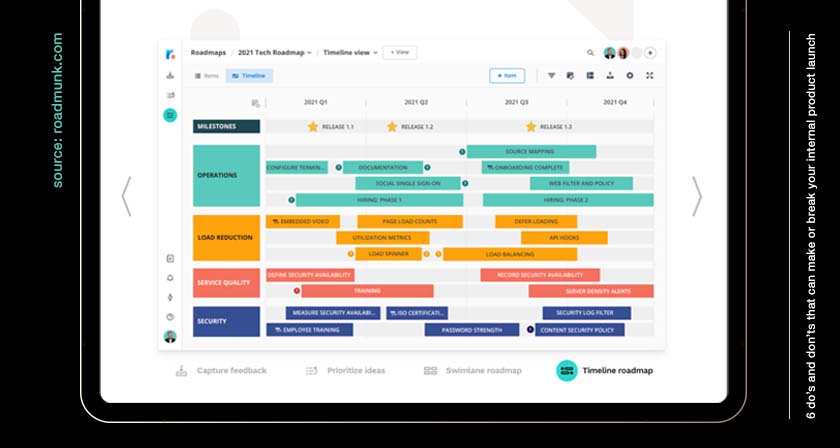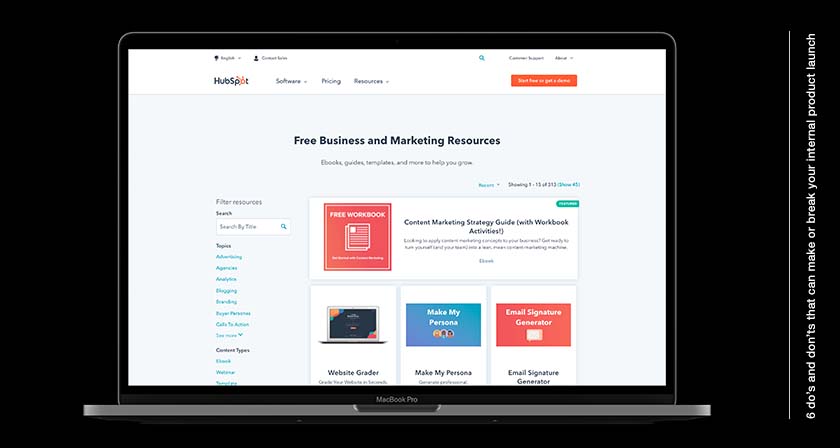
6 do’s and don’ts that can make or break your internal product launch
An internal product launch - what you need to know, and what you need to avoid.
So, you’ve developed a product. You want to set your organisation up for long-term success and feel you have to launch your product internally to key stakeholders before releasing it to customers.
But how do you get started the right way?
This article provides tips on best practices for an internal product launch, including what you should do and what you should avoid.
What are the ultimate goals of an internal product launch?
Internal product launches are just as essential as external ones because they allow you to achieve multiple key goals.
First off, they help organisational stakeholders stay in the loop. Internal launches help you prove the strategic importance of your new offering to all employees and board members, which is paramount to its success in the market (after all, it’s hard to get prospects excited about your product if your organisation as a whole doesn’t see the value in it!).
Having an intentional strategy can boost interest and productivity, as everyone is more likely to feel like they’re working towards one common goal: maximising the success of your external product launch event.
Another goal of internal product launches is to ensure that all departments have the same understanding of your product and the value it provides before it is rolled out to the public.
There are clear benefits to this. If your marketing and sales teams are both aligned on product benefits and key messages, it’s a lot more likely that your sales cycle will shorten and your conversion rates will improve. Other customer-facing departments (i.e. customer service) will also be able to prepare more effectively, empowering them to interact with customers in a more efficient and meaningful way.
It’s important to keep these goals in mind when you’re planning your internal launch. Reminding yourself why you’re showcasing your product to your organisation in the first place will allow you to strategise in a way that helps you avoid the following missteps.

6 don’ts that can break your internal product launch
Don’t let internal stakeholders know at the last minute
Launching a new product is almost always a complex group effort that requires preparation and input from a variety of departments and stakeholders. Because of this, timing is a crucial part of your internal launch strategy. This doesn’t necessarily mean you need to let everyone know several months before your launch day, but you should leave enough time between your internal and external launch so you can set realistic milestones for each department.
A good idea would be to create an internal product launch calendar to help you visualise these milestones. Tasks that require more time (like developing sales enablement assets) should begin at an earlier stage. If you’re not certain how long a certain task will take, be sure to ask the relevant team in advance.

Don’t overwhelm people with irrelevant information
Not supplying enough information about your upcoming product is something you should be mindful of. However, there’s arguably a greater risk in giving too much detail when it comes to your initial announcement – especially in larger organisations. Busy salespeople, for instance, might see a lot of information that doesn’t directly apply to their department. As a result, they may feel confused, overwhelmed or disengaged. This means they won’t give your announcement the attention it deserves. If you’re looking to strengthen the uptake of the information you’re delivering to a specific department, avoid burying the most relevant information with the generic bits.
Don’t overuse marketing jargon
It’s no secret – product marketing teams use a lot of jargon. Unfortunately, this doesn’t necessarily translate well to other departments. If your sales, customer service and IT teams don’t have a clear understanding of what you mean, your customers will not either. Before you send any collateral, go through it and make sure that it doesn’t contain any specific terms that only you and your team use. Limit the marketing lingo and simply focus on the key takeaways.
If you decide to tailor your communication to different departments, take it one step further and use the language that they speak. This can help employees connect with your new product more quickly and effectively, which is key if you want them to become advocates for it. After all, they need to be impressed too – not just your customers!
Don’t rely on one communication channel for your product launch
It’s not always easy to get the attention of internal stakeholders, especially in large organisations. Because of this reason, it’s important to broadcast your message using a variety of communication channels. IT technicians, for instance, may prefer using instant messaging (such as Slack or Google Chat) to communicate with each other, whereas customer service workers may feel more comfortable with email updates. Covering the most relevant channels will boost your product’s visibility and prevent disengagement.

Don’t rely on one type of collateral
Not everyone absorbs and processes information the same way, so it would be a mistake to create only one type of marketing and sales collateral. Other than using a variety of communication channels, it’s equally essential that you highlight key information about your product in different ways. Some people may find written content (i.e. brochures, memos and leaflets) to be more challenging to read; others may prefer it over videos or face-to-face meetings.
Don’t neglect departments that are less relevant to your product launch
It may seem logical to prioritise input from departments that have more of a direct role to play in your product launch (such as sales). However, you may receive invaluable feedback from other departments as well, like admin and operations. Being open to feedback from all stakeholders is key to being a customer-orientated company, which will naturally help you plan more effective launches in the future.
6 do’s that can make your internal product launch more effective
Set specific launch objectives
As mentioned earlier in this article, the purpose of internal product launches isn’t just to let internal stakeholders know about your new offering. Because there are multiple things you should aim to achieve with your product launch, always set specific and measurable objectives to keep you and your team accountable by the end of the process. Consider what you want to happen before your external launch. If you’re a software company, for example, you may wish to enrol at least 50 employees in your early user testing programme.
Conduct informal stakeholder research
External marketing strategies require audience research; internal product launches are no different. When you’re in the process of planning how you’re going to communicate with internal stakeholders, it’s often useful to consult with the leadership in each department. This will positively shift the dynamic by demonstrating that you see your internal launch as an opportunity to facilitate collaboration and two-way communication. If you want other departments to increase their buy-in and commitment, this is key.
To help you further understand the needs, priorities and challenges that your internal stakeholders have, create an internal persona research document. This will allow you to consolidate all the information you have collected.

Decide your product narrative
It’s worth remembering that there are a few details that everyone in your company must know, regardless of their role. Your product narrative (or product brief) should contain a one-line description that captures the value of your product. It should also include key dates, key product benefits and your positioning statement. Doing this will ensure a consistent level of understanding across your entire organisation.
Craft tailored messages for each department
Once you’ve honed in on the product narrative, the next ideal step would be to begin crafting tailored messages for each department. A helpful question to ask at this stage is: how will the new product change the way they work? Your organisation’s marketing department would most likely need to launch new marketing campaigns, which would also mean new landing pages and website updates. Customer service teams, however, would need to be trained on the specific features and functionalities of the product, so they can support customers to the best of their ability.
Create a centralised knowledge base
In the weeks following your initial product launch, your team have likely developed a range of collateral – including sales enablement assets, meeting recordings, and so on. To make the most of them going forward, create a centralised knowledge or resource base that can be accessed by all internal stakeholders in your company. This will give employees the ability to refresh their understanding of your product in their own time, reducing the amount of support requests you’ll receive.
If you’re looking for an example to use as inspiration, take a look at Hubspot. Their resource hub contains well-organised and well-curated collections of resources that come in a wide variety of formats, ranging from templates and toolkits to eGuides and articles.

Continue to provide support with a feedback system in place
Creating an online repository for people in your organisation is important, but support shouldn’t end there. Internal launches are especially prone to unexpected problems. What’s more, your product team will probably receive a lot of feedback until a few months after your product goes live. Because of this, it’s important to design a system that will allow you to efficiently follow up with questions and issues that require your attention.
Conclusion
Internal product launches are just as important as external launches, even though they may not be recognised as such. In large organisations with many employees, they become an absolute necessity because they’re the most effective way to increase every department’s commitment to ensuring the long-term success of your upcoming product.
However, to achieve this, a great deal of planning and consideration is required. Just like external launches, internal launches are not singular events but rather staged processes that involves heavy cross-departmental collaboration and communication. What’s more, your launch strategy must be accommodating to different internal stakeholders and take their preferences into account. Doing so will help you get maximum buy-in for your product.
Read the latest positioning trends and insights.
Tap into our brand and product positioning, storytelling, and creative expertise to inspire your next strategic move.

